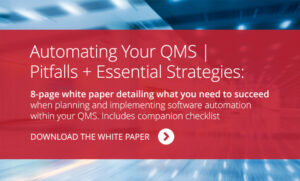April 17, 2017
A common pitfall in QMS process automation occurs with a poorly planned process automation strategy. Too often, the temptation is to automate all quality processes at once and streamline the entire eQMS process in one giant undertaking. However, real-world experience has proven that this approach is just not feasible for long-term quality management success.
This blog is part of a three-part series on proven strategies to help avoid QMS implementation failures. The first blog article describes the best practices approach to building a QMS implementation team. The second blog article reviews considerations for documenting quality processes prior to automation.
Prioritizing QMS Process Automation: What to Consider
When prioritizing your quality and compliance processes, weigh the importance and interconnections each will have. The genesis of leading-edge quality management and compliance ecosystem should start with one process determined by a key driving factor. Consider the following types of drivers when organizing your quality management system:
(1) Critical Non-compliant Quality Processes
In the most serious cases, automate the most critical process identified as non-compliant. Are your processes failing to meet minimum requirements? Did your team just exhaust 600 staff hours preparing for an audit? Even worse, did you receive an FDA warning letter?
(2) Ineffective Quality Processes
Logically, if a process is ineffective, manual, redundant, or exists on a labor-intensive legacy quality management system, automate it. Look for processes that are essential to moving faster and more efficiently. For example, many organizations start by centralizing the complaint management process. As a result, they see an extensive reduction in labor hours, faster time to resolution, and have a single point of reference for all issue management.
(3) Good Quality Processes that Should be Better
Organizations not under regulatory compliance pressure will benefit by starting with a process of lesser complexity across the quality value chain. A process may be working now but could be accelerated within days of automation. In this case, you achieve a large impact for the least amount of effort.
(4) Universal Quality Processes
A universal process like corrective and preventive actions (CAPA) is the FDA’s most expected platform for maintaining GMP compliance and meeting 21 CFR Part 11 and ISO standards. An effective CAPA plan has proven to lead to other quality management system and process improvements.
Avoid the Waterfall for QMS Process Automation
In a traditional developer waterfall model, each implementation phase must be completed sequentially before the next phase can begin. In this case, the disadvantage of waterfall development is that it doesn’t allow for much reflection or collaboration. If the design requirements set forth at the outset are faulty in any manner, the project is at risk of failure. In the testing stage, it is very difficult to change something that was missed in the design stage.
For QMS process automation, set small, achievable milestones and allocate reasonable time for periodic analysis.
Select a Flexible QMS Platform

The Automating Your QMS white paper details common pitfalls, essential strategies, and real-world scenarios when automating your quality management system.
Conclusion
Put detailed consideration into the deployment of your QMS process automation strategy. Be clear about which priority is the most critical and set reasonable milestones and expectations. Work in partnership with your QMS vendor to make the project as seamless as possible. The success of your first process launch will set the tone for future system expansion and new initiatives.
Three-Part QMS Implementation Best Practices Blog Series
The first blog article in our three-part blog series offers a best practices approach for organizing and managing a QMS implementation team. The second blog article reviews considerations for documenting quality processes prior to automation.


